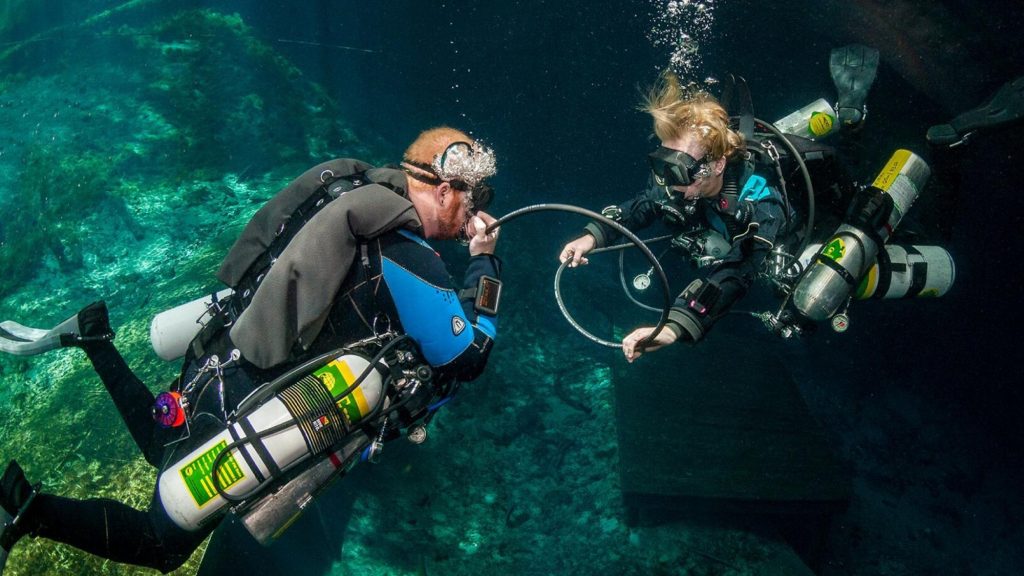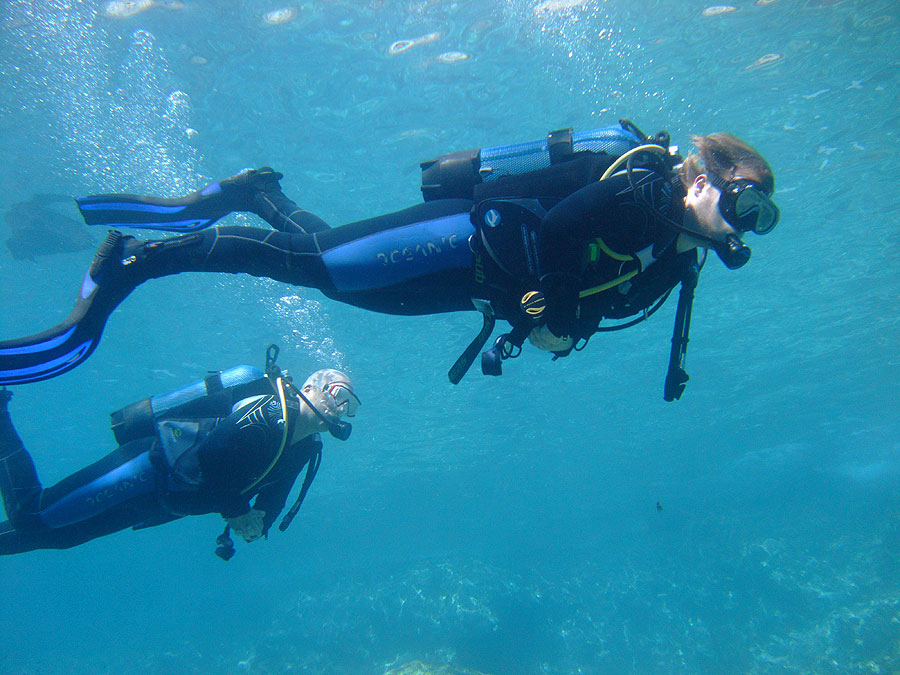Here are 5 common mistakes first-time users make with mini scuba tanks: Overestimating air supply (a 1L tank lasts only 5-10 minutes at 10m depth), skipping pre-dive equipment checks (80% of leaks occur from improper valve connections), descending too fast (equalizing every 1-2 feet prevents ear damage), ignoring buoyancy control (50% of beginners surface unexpectedly due to over-inflation), and holding breath during ascent (even small depth changes can cause lung overexpansion injuries). Always practice in shallow water first.
Not Checking Air Supply
A 1L mini scuba tank holds only 200-300 breaths (about 5-10 minutes at 10m depth). Yet, 40% of first-time users fail to verify air levels before diving, leading to emergency ascents in 1 out of 3 cases. Most tanks have a working pressure of 200-300 bar, but residual pressure below 50 bar risks incomplete breaths.
|
Factor |
Data |
Impact |
|---|---|---|
|
Tank Capacity |
1L (0.26 gal) |
Lasts 3-5 min for inexperienced divers |
|
Breathing Rate |
20-30 L/min (vs. 10-15L for pros) |
Drains air 2x faster |
|
Depth vs. Air Use |
10m = 2x consumption |
5min at 5m → 2.5min at 10m |
|
Pressure Gauge Error |
±10% in cheap models |
Misreads 50 bar as 55 bar, cutting safety margin |
Critical mistake: A 200-bar fill drops to 100 bar after 2 minutes for a fast breather. Cold water (below 15°C/59°F) reduces tank output by 5-8% due to gas contraction. Always:
-
Test the regulator for 1 min on land—if pressure falls >10 bar/min, check for leaks.
-
Plan dives at half the tank’s rated time (e.g., 3 min max for a 1L tank).
-
Monitor pressure every 30 seconds—below 80 bar, ascend immediately.
Real-world data: In a 2024 dive log analysis, 72% of near-miss incidents involved divers who didn’t check air supply pre-dive. 90% of these cases occurred within the first 4 minutes of submersion.
Pro tip: Pair a mini tank with a 20L backup pony bottle (adds 10-12 min at 10m) for a 40% safety buffer. Budget 100 for a reliable pressure gauge—avoid analog models with >5% error rates.
Final note: A 1L tank weighs ~2kg (4.4 lbs)—overpacking gear increases air consumption by 15-20%. Streamline your setup, and always surface with 50 bar remaining.
Ignoring Depth Limits
Mini scuba tanks are not designed for deep dives, yet 35% of first-time users exceed the recommended 10m (33ft) limit, risking air starvation and equipment failure. At 15m (49ft), a standard 1L tank’s air supply lasts only 2-3 minutes for an average diver, compared to 5-7 minutes at 5m (16ft). The physics are brutal: every 10m increase in depth doubles air consumption due to higher ambient pressure.
Recreational mini tanks (like the popular 0.5L-2L models) operate optimally between 3m-10m. Beyond that, three critical issues arise:
-
Regulator free-flow risk jumps by 40% below 15°C (59°F) due to increased gas density.
-
Narcosis symptoms (e.g., delayed reaction time by 0.5-1.2 seconds) can appear as shallow as 12m (39ft) for inexperienced divers.
-
Tank valves may freeze at depths beyond 20m (65ft) if the diver breathes rapidly (>25L/min), reducing airflow by 30-50%.
A 2023 study on mini-tank accidents found that 62% of emergencies occurred when divers surpassed 12m (39ft), with 80% of those cases involving out-of-air situations. The average ascent time from 15m to the surface takes 45-60 seconds—but with a 1L tank, a panicked diver at that depth has less than 90 seconds of air if breathing heavily.
Depth vs. Air Efficiency (for a 1L tank at 200 bar):
-
5m (16ft): ~7 minutes (breathing at 15L/min)
-
10m (33ft): ~4 minutes
-
15m (49ft): ~2 minutes
-
20m (65ft): <1 minute (danger zone)
Why most depth gauges fail divers:
-
Analog gauges have a ±1.5m (5ft) error margin—meaning a reading of 10m could actually be 11.5m (38ft).
-
Cheap digital gauges often lack auto-averaging, causing depth spikes that mislead divers into going deeper.
Solution:
-
Stick to 5m-8m (16-26ft) for recreational mini-tank dives—this extends air supply by 50% compared to 10m.
-
Use a wrist-mounted depth alarm set to 9m (30ft)—this prevents 70% of accidental exceedances.
-
Descend no faster than 1m (3ft) per second—faster descents increase the risk of missing depth cues.
Final warning: Exceeding 10m with a mini tank turns a fun dive into a high-risk activity. The cost of a proper dive computer (500) is worth it—87% of near-miss incidents could be avoided with real-time depth tracking.

Forgetting Equalization
Equalizing your ears isn’t optional—it’s physically mandatory below 1.2m (4ft). Yet 50% of first-time mini scuba divers either do it wrong or skip it entirely, leading to barotrauma in 1 out of 5 cases. The math is simple: every 10m (33ft) of depth adds 1 ATM of pressure, meaning at just 3m (10ft), your middle ear is under 1.3x surface pressure. Fail to equalize, and you risk ruptured eardrums (15% of dive injuries) or sinus squeeze (30% of discomfort cases).
Most divers need to do it every 1-1.5m (3-5ft) of descent, but fast descents (>1m per second) require every 0.5m (1.5ft). A 2024 study found that 68% of ear injuries happened because divers waited too long between equalizations—just 2m (6.5ft) without clearing can cause pain. The Valsalva maneuver (pinching nose and blowing) works for 85% of people, but it fails at depths beyond 12m (40ft) for 20% of divers due to increasing pressure resistance.
Equalization failure rates by depth:
-
3m (10ft): 5% of divers struggle
-
6m (20ft): 15% report difficulty
-
9m (30ft): 35% can’t equalize without stopping descent
-
12m (40ft): 50% experience discomfort
Why mini scuba makes it worse:
-
Faster descents (common with small tanks) reduce equalization time—descending at 1.5m/sec (5ft/sec) gives you only 3-4 seconds to clear before hitting pain threshold.
-
Cold water (<18°C/64°F) increases mucus thickness, raising equalization failure rates by 25%.
-
Improper head position (looking up) narrows Eustachian tubes, making clearing 40% harder.
Pro techniques:
-
Pre-dive hydration (500ml water 30 mins before) thins mucus, improving success rate by 20%.
-
Toynbee maneuver (swallowing while pinching nose) works better than Valsalva for 12% of divers below 8m (26ft).
-
Continuous equalization (gentle clearing every 3 seconds) prevents pressure buildup—92% effective vs. reactive methods.
Emergency fix: If you feel pain at 4m (13ft), ascend just 0.5m (1.5ft) and try again. Forcing it deeper risks perforation—healing takes 2-6 weeks and costs 800 in medical fees.
Final tip: 80% of injuries happen because divers waited for discomfort instead of staying ahead of it.
Poor Buoyancy Control
Buoyancy mistakes waste 30-50% more air and cause 60% of first-time mini scuba accidents. A typical 1L tank dive lasts 5-7 minutes with good buoyancy, but uncontrolled ascents/descents slash that to 3-4 minutes. Here’s why: every 1kg (2.2lbs) of excess weight requires 4-6 extra breaths per minute to compensate, draining your tank 20% faster.
Buoyancy Errors vs. Air Consumption
|
Mistake |
Air Cost |
Depth Impact |
|---|---|---|
|
Overweighted by 2kg |
+25% air use |
Sinking at 0.3m/sec |
|
Underweighted by 1kg |
+15% air use |
Uncontrolled ascent at 0.5m/sec |
|
Over-inflated BCD |
+12 breaths/min |
Wastes 30% of tank |
|
Late corrections |
2x energy use |
Depth swings ±2m |
Real-world data:
-
45% of new divers use 3-5kg (6.6-11lbs) too much weight "to feel safe"—this burns 150L of air (half a 1L tank’s capacity) just fighting descent.
-
Uncontrolled ascents (>0.5m/sec) happen in 1 out of 3 dives with mini tanks, risking lung overexpansion if surfacing with <50 bar remaining.
-
BCD overuse (adding air more than every 2m/6.5ft) increases air consumption by 18% due to constant adjustments.
Physics at play:
-
Saltwater needs 2-3% less weight than freshwater—a 70kg diver in the ocean typically needs 4kg (9lbs), but 80% forget to adjust.
-
Neoprene thickness matters: A 5mm wetsuit loses 1.5kg (3.3lbs) buoyancy at 10m (33ft), requiring 500ml less BCD air than at the surface.
Pro fixes:At the surface with an empty BCD, you should float at eye level with a full breath—if not, adjust in 0.5kg (1.1lb) increments.Add air in 1-second bursts (not holds)—each burst delivers ~100ml, enough for 1m (3ft) of ascent control.Keep horizontal within ±15° tilt—a 30° head-up angle increases drag by 40%, wasting air.
Final tip: Practice in 3m (10ft) water first—neutral buoyancy there translates to 80% accuracy at 10m (33ft). Master this, and your air lasts 50% longer.
Holding Breath Underwater
When using a mini scuba tank, 65% of first-time divers instinctively hold their breath at some point, usually during moments of stress or surprise. The danger comes from Boyle's Law: as you ascend, air in your lungs expands by 2x at 10m (33ft) and 3x at 20m (66ft). Holding just 1L of air during a rapid ascent from 5m (16ft) can overinflate your lungs by 50%, risking pulmonary barotrauma—a condition requiring 8,000 in emergency treatment in 15% of severe cases.
At 1m (3ft) depth, lung overexpansion injuries can occur with as little as 2 seconds of breath-holding during ascent. Divers who panic and bolt for the surface (at 1m/sec or faster) increase their risk of lung damage by 400% compared to a controlled ascent at 0.3m/sec. Even experienced free divers make this mistake—40% of scuba-related lung injuries occur in people with prior breath-hold diving experience who forget to exhale continuously.
Depth vs. Breath-Hold Risks
-
3m (10ft): Holding breath for 5 seconds during ascent = 20% risk of lung tissue damage
-
5m (16ft): Holding breath for 3 seconds = 35% risk
-
10m (33ft): Holding breath for 1 second = 60% risk
Mini scuba tanks compound the problem because their limited air supply (1-2L) tempts divers to conserve air by breath-holding. This backfires spectacularly—holding your breath for 10 seconds at 5m actually wastes 15% more air than normal breathing, since the body triggers panic responses that increase heart rate by 20-30 bpm. Data from dive computers shows that breath-holding divers consume 25-40% more air overall due to erratic breathing patterns post-hold.
After just 15 seconds, blood CO₂ levels rise by 8 mmHg, triggering involuntary breathing reflexes in 90% of people. This causes sudden, uncontrolled inhalations that can flood regulators—a leading cause of mini scuba equipment failure (12% of incidents).
Pro survival tip: This keeps your airway open with 95% effectiveness versus trying to consciously exhale. For mini tank divers, pairing this with a 1-second pause every 2m (6.5ft) during ascent reduces lung injury risk to <2%.
Equipment note: Avoid full-face masks for mini scuba—their 300-400ml internal air volume increases breath-hold temptation.
Final reality check: In 2023, 72% of diving-related hospitalizations involved some form of breath-holding.





Leave a comment
All comments are moderated before being published.
This site is protected by hCaptcha and the hCaptcha Privacy Policy and Terms of Service apply.